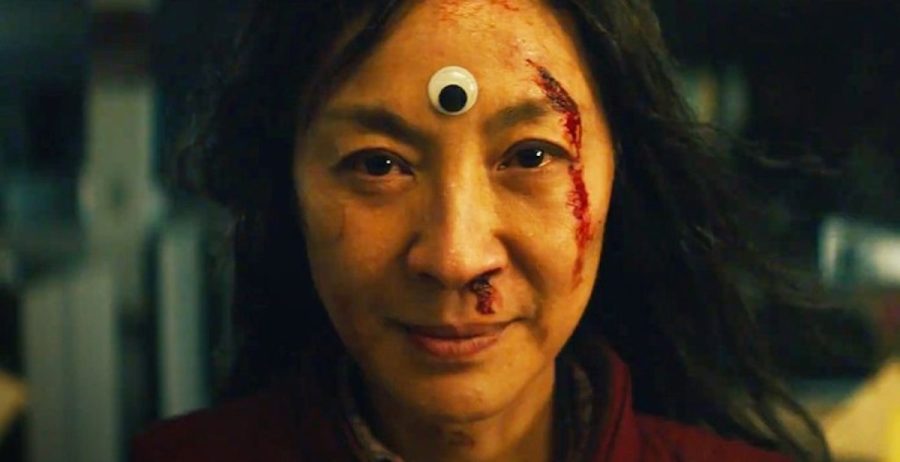“Everything Everywhere All At Once” and intertextuality in modern movies
One reason you should see the new movie as soon as possible
Photo by SUBMITTED
Michelle Yeoh as Evelyn Wang
If you haven’t seen “Everything Everywhere All At Once” yet, do yourself a favor and buy a ticket right now.
The movie has something to offer anybody — poignant commentary on generational trauma, awesome sci-fi action sequences, a goofy sense of humor and even a resonant romantic thread.
Any of these topics, as well as the techniques that writer-directors Daniel Kwan and Daniel Scheinert use to execute them, could be talked about long enough to fill an article.
However, I want to focus on one aspect of the film specifically, and that’s its use of intertextuality.
Warning: I recommend going into this movie as blind as possible, even if it means waiting to read this article. There won’t be any serious spoilers but I figured I’d still give a heads up.
Intertextuality is a divisive topic in modern media.
Essentially, it refers to creators using the audience’s knowledge of other media to inform the piece they are currently consuming.
Common examples would be “Stranger Things” building its design and atmosphere around references to 1980s pop culture, or Marvel movies requiring the viewer to be aware of other Marvel movies for the story to make sense.
Another common example of intertextuality is the use of parody. Comedies have used parody as a tool for generations. Many of the show “Community’s” most acclaimed episodes are parodies of popular tropes or movies.
Intertextuality is an inherent part of all media, but in the cinematic universes and nostalgia-driven media of the 2010s it has become crucial to many media experiences.
In “Everything Everywhere,” the Daniels also use the audience’s awareness of other media as a storytelling tool, but in a very different way than those other examples.
Without revealing too much, the premise of the film is that a middle-aged Chinese-American immigrant named Evelyn must battle an interdimensional threat.
In order to do this, Evelyn uses a device that allows her to experience the alternate paths her life could have gone down.
It’s a little complex, and the early minutes of the movie carefully ease the audience into this idea.
For example, Evelyn is able to briefly hop into an alternate version of her life where she became a kung fu master, and then is able to use the memories of that training to fight off enemies in her world.
A lot of these other universes are built as references or versions of well-known film ideas, including “Ratatouille,” “Crouching Tiger, Hidden Dragon” and even the opening of “2001: A Space Odyssey.”
So, let me explain how “Everything Everywhere” uses the tool of intertextuality in a different way than something like “Stranger Things” or “Community.”
“Community’s” use of previously existing media is like Weird Al parodying a song. The show takes existing media, and applies a silly, deconstructive layer to it.
“Stranger Things” is like musicians using chord structures and sounds from the 80s to give their music a nostalgic feel.
“Everything Everywhere,” on the other hand, uses pre-existing media in the way that great hip-hop producers use samples in their songs.
The movies referenced in “Everything Everywhere” aren’t used as a punchline or as nostalgia bait. They’re treated with respect, and recontextualised within the movie to have new meaning and add additional meaning to the story.
One major film parodied in “Everything Everywhere” is the Hong Kong romantic drama “In the Mood for Love.”
Within this silly sci-fi comedy, the filmmakers use the framework of a very serious romantic drama to allow two of the main characters to address their own romantic and personal differences, leading to a pivotal moment in the movie.
It’s like when rapper-producer-famous jerk Kanye West used the soul classic “Through the Fire” by Chaka Khan as a sample in his early hit “Through the Wire.”
If you listen closely, the sample’s lyrics, which are used throughout the song’s beat, are clearly still “through the fire,” but because of their new context the listener hears it as “through the wire.”
The sample is given new meaning through its use in an entirely new context without degrading the original.
We live in a world where every movie is shaped by the hundreds of movies that have come before it. There are a million corporate reboots, sprawling franchises, and nostalgia-bait throwbacks coming out every year.
So, finding a way to still use the audience’s awareness of stories of the past while creating something one hundred percent new and unique is an amazingly refreshing and revolutionary act.
My point is you need to go see “Everything Everywhere All At Once.” Like, right now.
Porisch can be reached at porischn7213@uwec.edu.

Nick Porisch is a third-year English student, and this is his fourth semester at The Spectator. Most of the time you can find him just sitting around someplace, potentially writing but usually just sitting. On the rare occasion he’s not sitting around, he might be rock climbing or running. But most likely he’s just sitting somewhere.


